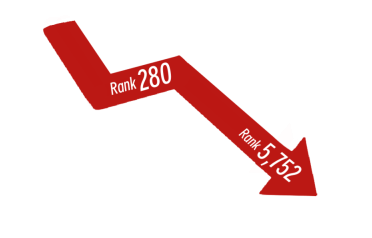
In October 2014, The Stinger published an article detailing a report on high schools nationwide, ranking Emmaus High School 280 among America’s 26,727 high schools. Ten years later, EHS’s ranking has dropped to a ranking of 5,752.
A Stinger-led investigation into the school’s descent reveals a combination of factors that contributed to this steep drop, from declining test scores and staffing turnovers, to shifting district priorities and broader educational trends. As Emmaus High School grapples with its new reality, the investigation underscores systemic issues that could have national implications for other public schools as well as EHS.
Beth Guarriello, EHS principal, spoke on behalf of administration on the new placement.
“Nobody wants to see that. We all were pretty upset when we saw that. I mean, numbers are numbers,” Guarriello said. “We did reach out to U.S. News & World Report and ask for the rationale, and what they told us was it all really came down to the Keystone testing.”
Act 158, passed by the Pennsylvania state legislature in 2018, revamped the state’s high school graduation requirements by offering students multiple pathways to demonstrate readiness for post-secondary success. The law allows students to graduate without passing the state’s Keystone Exams, which were once the primary graduation standard. Instead, students can meet graduation requirements by earning a passing grade on class-based assessments, demonstrating career or technical competency, or meeting a combination of alternative benchmarks, such as scoring well on standardized tests like the SAT or securing a job-ready credential.
This change provides more flexibility for students with diverse career goals while maintaining a focus on academic and career preparedness; however, with students caring less about Keystone grades, this act negatively impacts EHS’ standing in the rankings.
The placement — which does not dictate the quality of education but rather displays how the school performs amongst others — cannot be used to immediately calculate how proficient a school is.
EHS’ Social Studies Department Chair and teacher Melissa Moxley notes that education quality should not solely be based upon student scores.
“It is hard to quantify a human experience, like education,” Moxley said. “Anecdotal evidence of: ‘How do kids feel? Do they feel supported? Do they feel like this is a place where they can learn? Do they feel their needs are being met? That is the first metric we should be looking at.”
Several factors contribute to the placement of a high school ranking, including English and math proficiency rates (only schools placed in the 80th percentile or higher are included), college readiness, enrollment and graduation rates, AP composite scores, SAT/ACT scores, retention rate (how long a student stays in the school or district), and counselor-to-student ratios.
EHS still exceeds the national average in a variety of target areas, meaning it still outperforms many other schools. According to greatschools.org, EHS reports its Keystone test proficiency scores, averaging around 73 percent in Literature and 60 percent in Biology, which places scores above national averages of 65 and 51 percent, respectively. EHS, however, does display below-average Algebra test scores of 26 percent, in comparison to a national average of 34 percent.
“There’s lots and lots of variables,” Guarriello said. “It is not just one thing. It doesn’t show the whole picture. It doesn’t show the awesome things that are happening in the service organizations and clubs or activities. They [U.S. News] really just look at test scores, which is tough.”
Every school is vastly different from the next, as socioeconomic factors, geographic area, and student body may all impact how a school is ranked, and it may be difficult to accurately reflect its overall quality due to said factors. “Students are so different, situations are different, socioeconomic status is different. I feel that oftentimes you are comparing apples and oranges,” Moxley said.
These numbers reflect a much larger national trend of high schools dropping in ranking. EPSD’s rival district, Parkland, ranks 3,298. Parkland reports a 30 percent AP participation rate — the same as EHS — with 25 percent passing at least one AP exam. U.S. News also reports Parkland test scores above the national average, reflecting numbers similar to Emmaus: 81 percent in literature, 80 percent in mathematics, and 48 percent in biology.
EHS displays an overall scorecard of 67.42/100 according to U.S. News. The score is calculated by monitoring AP exam participation and passage, mathematics proficiency, literature proficiency, science proficiency, and graduation rate.
“There is so much more that goes into growing up and learning. There is so much more that goes into a school, far beyond what is taught in a classroom.” Guarriello said.
The decline in academic performance can also be attributed to the substantial impact of the post-COVID-19 situation on schools. The mental well-being of students at Emmaus High School, along with many others across the nation, has been significantly impacted by the COVID-19 pandemic. There has been a noticeable increase in the levels of depression, anxiety, and feelings of isolation among high school students nationwide.
According to a report from the Center for Disease Control and Prevention (CDC), 37 percent of U.S. high school students experienced poor mental health during the pandemic. This decline in mental health has had a profound impact on academic performance.
“We’ve got great kids and phenomenal teachers who are working very hard. The ranking, although I would love it to be higher, doesn’t show the full picture and doesn’t show the work that’s being done in the school, the care that’s being given to the kids,” Guarriello said. “There’s a lot of great things going on. There’s a lot more to this school than just a number.”






